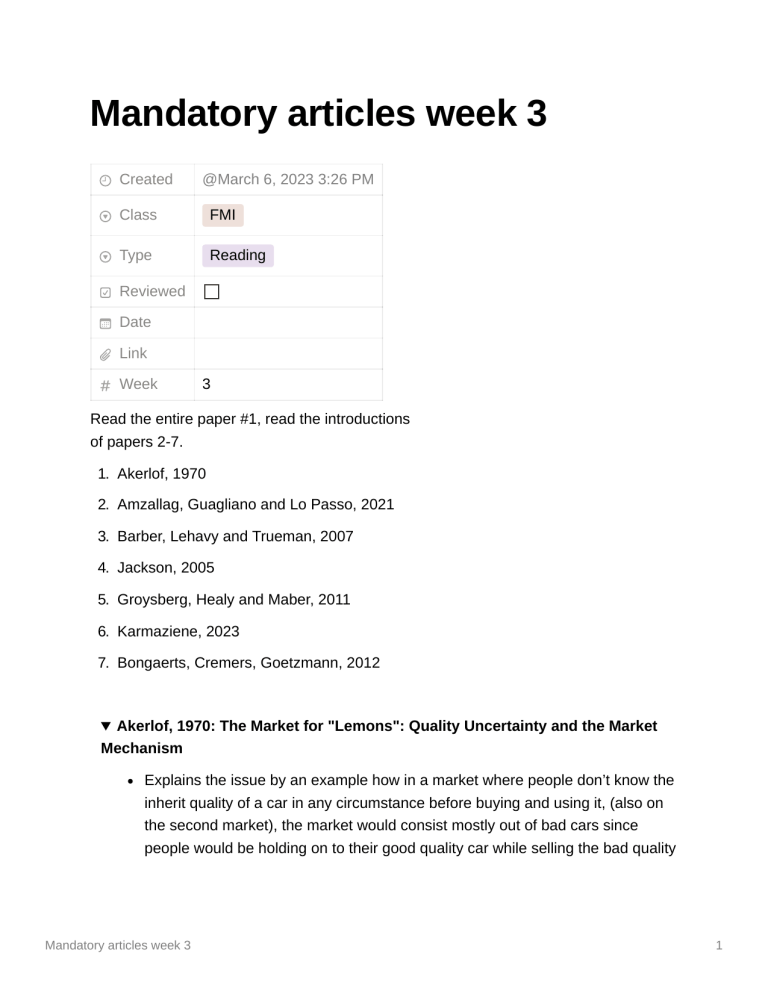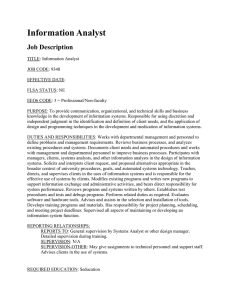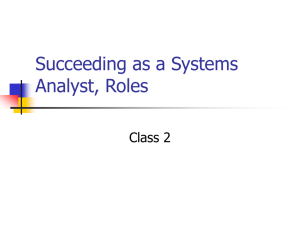
Mandatory articles week 3 Created @March 6, 2023 3:26 PM Class FMI Type Reading Reviewed Date Link Week 3 Read the entire paper #1, read the introductions of papers 2-7. 1. Akerlof, 1970 2. Amzallag, Guagliano and Lo Passo, 2021 3. Barber, Lehavy and Trueman, 2007 4. Jackson, 2005 5. Groysberg, Healy and Maber, 2011 6. Karmaziene, 2023 7. Bongaerts, Cremers, Goetzmann, 2012 Akerlof, 1970: The Market for "Lemons": Quality Uncertainty and the Market Mechanism Explains the issue by an example how in a market where people don’t know the inherit quality of a car in any circumstance before buying and using it, (also on the second market), the market would consist mostly out of bad cars since people would be holding on to their good quality car while selling the bad quality Mandatory articles week 3 1 cars since they go for the same price. The buyer decides not to buy since only poor quality items→Market breaks down. In equilibrium the supply must equal the demand for the given average quality, or S(p) = D (p, p(p)). As the price falls, normally the quality will also fall. And it is quite possible that no goods will be traded at any price level. This can be derived from utility theory. Other examples of issues arising for information asymmetry are listed Insurance Only people with bad health sign up for insurance while insurance can analyse bad health well (information asymmetry)→ Prices generally get higher because of wrong underwriting → Only attractive to people with worse health than the average → loop starts again Employment of minorities Information asymmetry between employers and employees → to fix this checkup with school of employee → unreliability of slum schools decreases the economic possibilities of their students. This leads to the main subject, The Costs of Dishonesty Markets can be dishonest by selling inferior goods which can’t be detected before buying because of information asymmetry. The presence of people in the market who are willing to offer inferior goods tends to drive the market out of existence as in the case of our automobile example. This means the cost also must include the loss incurred from driving legitimate business out of existence. This leads to the main subject, Dishonesty in business is a serious problem in underdeveloped countries There is considerable evidence that quality variation is greater in underdeveloped than in developed areas. Entrepreneurship can defeat asymmetry by having the knowledge and guaranteeing a good product The problem, of course, is that entrepreneurship may be a scarce resource Credit markets in underdeveloped countries often strongly reflect the operation of the Lemons (bad cars) Principle Mandatory articles week 3 2 Because of asymmetrical information people tend to rely on people inside their community which they deem reputable. Numerous institutions arise to counteract the effects of quality uncertainty. One obvious institution is guarantees. Most consumer durables carry guarantees to ensure the buyer of some normal expected quality. One natural result of our model is that the risk is borne by the seller rather than by the buyer. Groysberg, Healy and Maber, 2011: What Drives Sell-Side Analyst Compensation at High-Status Investment Banks? Large, systematic swings in the level and skewness of real compensation throughout the 1988 to 2005 period. Level and skewness of compensation over time was driven almost exclusively by bonus awards Second, most of the variation in analyst compensation can be explained by four factors 1. Recognition by Institutional Investor as an “All-Star” analyst 2. Recognition by the Wall Street Journal 3. An analyst’s investment-banking contributions 4. The size of an analyst’s portfolio. First factor brings in the most compensation The sample firm’s analysts, forecast accuracy plays an insignificant role in determining compensation. Inaccurate analysts at the sample bank are more likely to move to lower status banks or exit We find that much of the WSJ “star stock-picker” compensation premium appears to reflect public recognition Barber, Lehavy and Trueman, 2007: Comparing the stock recommendation performance of investment banks and independent research firms Mandatory articles week 3 3 This study has compared the performance of recommendations issued by analysts at investment banks with those prepared by analysts at independent research firms (securities firms without investment banking business). Over the February 1996–June 2003 time period we find that the buy recommendations of independent research firms outperform those of investment banks by an average of 3.1 basis points per day. The outperformance of independent research firms’ buy recommendations is concentrated in the bear market period, where they generate an average daily abnormal return that is 6.9 basis points greater than that of the investment banks buy recommendations. Investment bank hold/sell recommendations, in contrast, outperform those of the independent research firms by 1.8 basis points daily, on average. These results, taken as a whole, are consistent with allegations in the Global Research Analyst Settlement that at least some investment banking analysts were reluctant to downgrade stocks whose prospects weakened during the bear market. We go on to separately analyze the performance of the recommendations of the ten banks sanctioned in the Global Research Analyst Settlement: Overall, we find that the buy recommendations of each investment banking category significantly underperform those of the independent research firms. Jackson, 2005: Trade Generation, Reputation, and Sell-Side Analysts This paper presents three main empirical findings: 1. high reputation analysts generate higher future trading volume. 2. accurate analysts are rewarded with higher end-of-period reputations as measured by survey rankings. 3. optimistic analysts generate more trading volume for their brokerage firms. In equilibrium, optimistic analysts indeed generate more short-term trading volume, even when investors are fully rational. However, as expected, an analyst’s reputation suffers when she misleads investors. An analyst who cares highly about her future reputation refrains from opportunistic behavior. Mandatory articles week 3 4 Groysberg, Healy and Maber, 2011: What Drives Sell-Side Analyst Compensation at High status Investment Banks? Prior studies have argued that analysts face strong, bonus-based forecasting incentives. This assumption is often motivated by associations between forecast accuracy and Institutional Investor “All-Star” status. Although All-Star status is strongly associated with analyst pay, the variation in All-Star status that drives analyst pay is orthogonal to forecast accuracy measured using a wide variety of forecast periods and estimation methods. The compensation consequences of All-Star status cannot be attributed solely to AllStar analysts having greater investment-banking deal flow Investment-banking contributions are an important determinant of analyst remuneration. But only equity underwriting activities are associated with analyst pay Karmaziene, 2023: Brokers earn trading commissions on trading volume regardless of how valuable their recommendations are for investors. Brokers’ utilities increase in commissions, and they may encourage analysts to issue trade-enhancing research. If brokers compensate analysts for trade-generating rather than for accurate research, the analysts face conflicts of interest. The existence of this conflict was assumed in past studies This paper contributes to the previous literature by empirically evaluating the broker turnover/analyst-compensation link and its magnitude. Bongaerts, Cremers, Goetzmann, 2012: we find that significant differences exist across multiple credit ratings of the same bond issue at the same point in time. Mandatory articles week 3 5 We find strong evidence that Fitch ratings have a regulatory certification effect. The likelihood of getting a Fitch rating is strongly associated with Moody’s and S&P ratings being on opposite sides of the HY—IG boundary. This suggests that, in equilibrium, Fitch ratings are sought as a kind of “tiebreaker” in these cases. During the sampleperiod, the most prevalent institutional rule for classifying rated bonds was as follows: for issues with two ratings, only the lower rating is used to classify the issue (e.g., into IG or HY); for issues with three ratings, the middle rating should be used (see, e.g., the National Association of Insurance Commissioners (NAIC) guidelines or the Basel II Accord).2 Therefore, if S&P and Moody’s ratings are on opposite sides of the HY—IG boundary, the Fitch rating (assuming it is the marginal, third rating) is the “tiebreaker” that decides into which class the issue falls. Notice that this rule directly implies that adding a third rating cannot worsen the regulatory rating classification, but may potentially lead to a higher rating. Amzallag, Guagliano and Lo Passo, 2021: The econometric analysis presented in this paper suggests that, after the introduction of the MiFIDII research unbundling provisions: 1. the quantity of research per SME is overall unchanged—or at most has only slightly declined—relative to larger firms; 2. The probability of an SME completely losing coverage has not increased relative to the probability faced by a larger firm; 3. The quality of SME research has not worsened relative to larger firms; 4. SME liquidity conditions have worsened, relative to larger firms, in terms of tightness (measured by bid-ask spreads), but not in terms of depth (measured by the Amihud illiquidity ratio and the turnover ratio). However, in absolute terms, SMEs continue to be characterised by lower amount of analyst research, higher probability of losing coverage, worse quality of research and limited market liquidity. Mandatory articles week 3 6 Mandatory articles week 3 7


